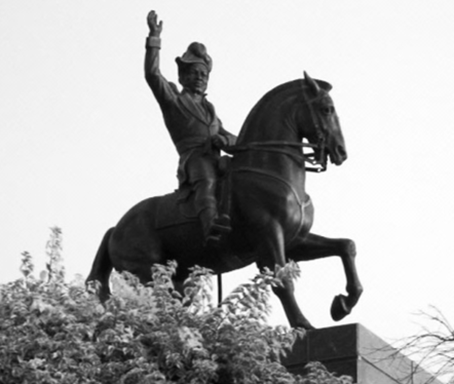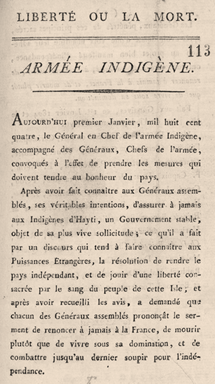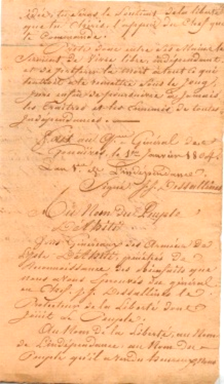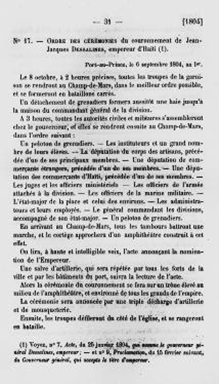"Haiti’s Independence" by Julia Gaffield, Ph.D.
Gaffield is Assistant Professor of History at Georgia State University. Her dissertation is on the Haitian Revolution in the Atlantic world. Gaffield rediscovered the first-known surviving copy of Haiti’s Declaration of Independence in the British archives. The document is available below.
 Today in the Champs-de-Mars in Port-au-Prince there is a statue of Dessalines. Surrounded by national flags, it honors him as the father of national independence. A slave before the revolution, Dessalines rose to military prominence in 1793 and soon achieved the status of general serving under Toussaint Louverture. Following Louverture’s deportation to France, Dessalines emerged as one of the principal leaders of the rebel forces in Saint Domingue. He managed to negotiate the alliance of diverse and opposing forces in order to defeat the French army sent by Napoleon in 1802. On 1 January 1804, Dessalines issued the world’s second formal declaration of independence and announced the independence of "Hayti."
Today in the Champs-de-Mars in Port-au-Prince there is a statue of Dessalines. Surrounded by national flags, it honors him as the father of national independence. A slave before the revolution, Dessalines rose to military prominence in 1793 and soon achieved the status of general serving under Toussaint Louverture. Following Louverture’s deportation to France, Dessalines emerged as one of the principal leaders of the rebel forces in Saint Domingue. He managed to negotiate the alliance of diverse and opposing forces in order to defeat the French army sent by Napoleon in 1802. On 1 January 1804, Dessalines issued the world’s second formal declaration of independence and announced the independence of "Hayti."
The hand-written text below, titled the "Acte de l’Indépendance," declared the end of French colonialism and resumed the name used for the island by the indigenous population prior to the arrival of Europeans. This geo-political reconfiguration concluded the thirteen-year "Haitian Revolution" and this text represents the second ever Declaration of Independence, or "Acte de l’Indépendance." The document includes three proclamations: first, a preamble, signed by Jean-Jacques Dessalines, the "general-in-chief;" second, a declaration on behalf of the people of Haiti, signed by Dessalines and other militaryleaders, including Christophe, Pétion, Clervaux, Geffrard, and Vernet; and third the nomination of Dessalines as Governor-General for life, signed by the generals and chiefs of the army. The document asks the new citizens of Haiti to swear eternal hatred to the French and to fight to the death for personal and national freedom: "Liberté ou la Mort." The original documents that Dessalines and his generals read and signed on 1 January 1804 are now lost. Transcriptions of the text, such as this one, exist in archives around the Atlantic world, which includes Haiti, Jamaica, England, France, Spain.
The next document below is the only know extant copy of the Haitian Declaration of Independence that was issued by the Government of Haiti. The last page of the document is stamped "Au Port-au-Prince, De l’Imprimerie du Gouvernement." This document was printed in the third week of January 1804 and Edward Corbet, the British Agent for Affairs in St. Domingo, brought the document back to Jamaica where he presented it to the Lieutenant Governor, George Nugent. Nugent then sent the document to the Secretary of State for War and the Colonies, Lord Robert Hobart, on 10 March 1804. The document was cataloged at the British National Archives with the Jamaican colonial records. It is an eight-page pamphlet that includes the three proclamations of the "Acte de l’Indépendance." The form of the document, a pamphlet, suggests that the document was created for an international audience. It could easily be mailed around the Atlantic World. The text was reprinted in newspapers in the United States and Europe. This particular document circulated to the British Empire because the Lieutenant Governor of Jamaica and Governor-for-Life Dessalines attempted to negotiate a trade agreement in the early months of Haiti’s independence.
This same day that Dessalines proclaimed Haiti independent he was was nominated Governor-General for Life. Later that year, that title was replaced with that of "emperor." On 20 May 1805, Dessalines published the country’s first constitution. It reaffirmed the island’s separation from France and the abolition of slavery. Furthermore, he declared that all Haitian citizens would be considered "black," thereby legally eliminating any racial hierarchy in the country. Dessalines’s political career ended abruptly when members of an opposition movement assassinated him on 17 October 1806.


